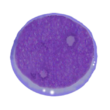Flow cytometry:ETP-ALL
From haematologyetc.co.uk
| 1. The primitive nature of the blast cells should be demonstrated |

The "primitive" morphology of blast cells is accompanied by signs of primitive immunophenotype
- In most cases, AML will demonstrate typical features of immature cells with: weak expression of CD45, and expression of CD34 and/or CD117. In difficult cases other markers of early differentiation may also help
Click for more detailed description of identifying primitive immunophenotype in AML - Potential difficulties may occur where blast cells have significant differentiation to more mature forms their primitive nature may be less easy to demonstrate. This is most frequently encountered in monocytic cases of AML, or in acute promyelocytic leukaemia (APL)
Click for a more detailed description of problem areas in identifying primitive immunophenotype
| 2. Myeloid lineage must be assigned |

Like Auer rods or granulation in morphology, immunophenotypic features support assignment to myeloid lineage
The criteria to assign myeloid lineage in AML have been established by the WHO, two alternative sets of criteria may be used (although most cases will meet both):
| Either Criteria 1 |
|---|
| A myeloid lineage-defining marker pattern is present and no lineage-defining markers of T or B cells are present (Click for detailed description) |
| Or Criteria 2 |
| At least two myeloid lineage-associated markers are present and there are no lineage defining markers of T or B cells and no more than one: T-cell or B-cell lineage-associated marker is present (Click for detailed description) (NOTE when assigning lineage based on these criteria, see also BPDCN in the alternative diagnosis list below) |
NOTE In some cases an extended marker panel may allow the pattern of differentiation to be identified (e.g. erythroid or megakarocytic). In difficult cases these markers may provide additional evidence of myeloid lineage (although their specificity is often less than the general myeloid-associated markers so care is required when using them in this way).
Click for table of extended marker set for AML immunophenotype
| 3. Alternative diagnoses should be considered and excluded |

In some cases lineage may be unclear - either because myeloid lineage cannot be confidently assigned, or because markers of other lineage are present - in such cases it is important to consider possible alternative diagnoses
- NOTE Some "non-lineage" markers are frequently expressed in AML and may be associated with specific AML subtypes, these do not necessarily indicate mixed phenotype (Click here for further detail)
- Other features should give concern for mixed phenotype or alternative diagnosis, it is important in such case that diagostic criteria and alternative diagnoses are carefully considered (see the table below more detailed guidance).
Table: Possible alternative diagnoses in difficult cases
| Mixed Phenotype Acute Leukaemia (MPAL) | |
|---|---|
| Consider MPAL if: you are able to assign myeloid lineage but the cells also express markers that meet the criteria for T or B cell lineage. ---- Click here for detailed description of MPAL types---- | |
| Acute Undifferentiated Leukaemia (AUL) | |
| Consider AUL if: There is insufficient evidence to assign myeloid lineage, and you cannot assign T-cell or B-cell lineage either ----Click here for detailed description of AUL---- | |
| Acute Leukaemia of ambiguous lineage not otherwise sepcified (ALAL-NOS) | |
| Consider ALAL-NOS if: classification to a single lineage is not possible, but classification cannot be made as AUL, or MPAL. ----Click here for detailed description of ALAL-NOS---- | |
| Early T-cell precursor ALL | |
| The marker pattern is of a primitive T cell neoplasm (cCD3 is expressed) but there are limited additional T markers, and at least one myeloid or stem cell marker is also expressed ----Click here for detailed description of ETP-ALL | |
| Blastic plasmacytoid dendritic cell neoplasm (BPDCN) | |
| The immunophotype of BPDCN may resemble AML or AUL (almost always with an accompanying skin rash). Myeloid-lineage markers (particularly CD33) are frequently expressed (in rare cases two myeloid markers may be co-expressed allowing potential assignment as AML, although MPO and CD34 should be absent). BPDCN should considered and evidence sought if clinical features fit. ---- Click here for detailed description of BPDCN---- |